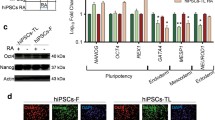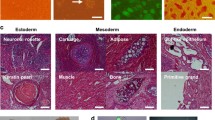Abstract
Retinoic acid (RA) is one of the most potent inducers of differentiation of mouse embryonic stem cells (ESCs). However, previous studies show that RA treatment of cells cultured in the presence of a leukemia inhibitory factor (LIF) also result in the upregulation of a gene called Zscan4, whose transient expression is a marker for undifferentiated ESCs. We explored the balance between these two seemingly antagonistic effects of RA. ESCs indeed differentiated in the presence of LIF after RA treatment, but colonies of undifferentiated ESCs eventually emerged from these differentiated cells — even in the presence of RA. These colonies, named secondary colonies, consist of three cell types: typical undifferentiated ESCs expressing pluripotency genes such as Pou5f1, Sox2, and Nanog; cells expressing Zscan4; and endodermal-like cells located at the periphery of the colony. The capacity to form secondary colonies was confirmed for all eight tested ESC lines. Cells from the secondary colonies — after transfer to the standard ESC medium — retained pluripotency, judged by their strong alkaline phosphatase (ALP) staining, typical colony morphology, gene expression profile, stable karyotype, capacity to differentiate into all three germ layers in embryoid body formation assays, and successful contribution to chimeras after injection into blastocysts. Based on flow cytometry analysis (FACS), the proportion of Zscan4-positive cells in secondary colonies was higher than in standard ESC colonies, which may explain the capacity of ESCs to resist the differentiating effects of RA and instead form secondary colonies of undifferentiated ESCs. This hypothesis is supported by cell-lineage tracing analysis, which showed that most cells in the secondary colonies were descendents of cells transiently expressing Zscan4.



Similar content being viewed by others
References
Akiyama T, Xin L, Oda M, Sharov AA, Amano M, Piao Y, Cadet JS, Dudekula DB, Qian Y, Wang W, Ko SB, Ko MS (2015) Transient bursts of Zscan4 expression are accompanied by the rapid derepression of heterochromatin in mouse embryonic stem cells. DNA Res 22:307–318
Amano T, Hirata T, Falco G, Monti M, Sharova LV, Amano M, Sheer S, Hoang HG, Piao Y, Stagg CA, Yamamizu K, Akiyama T, Ko MS (2013) Zscan4 restores the developmental potency of embryonic stem cells. Nat Commun 4:1966
Callicott RJ, Womack JE (2006) Real-time PCR assay for measurement of mouse telomeres. Comp Med 56:17–22
Carter MG, Sharov AA, VanBuren V, Dudekula DB, Carmack CE, Nelson C, Ko MS (2005) Transcript copy number estimation using a mouse whole-genome oligonucleotide microarray. Genome Biol 6:R61
Colleoni S, Galli C, Gaspar JA, Meganathan K, Jagtap S, Hescheler J, Sachinidis A, Lazzari G (2011) Development of a neural teratogenicity test based on human embryonic stem cells: response to retinoic acid exposure. Toxicol Sci 124:370–377
Edwards MK, McBurney MW (1983) The concentration of retinoic acid determines the differentiated cell types formed by a teratocarcinoma cell line. Dev Biol 98:187–191
Falco G, Lee SL, Stanghellini I, Bassey UC, Hamatani T, Ko MS (2007) Zscan4: a novel gene expressed exclusively in late 2-cell embryos and embryonic stem cells. Dev Biol 307:539–550
Fujii S, Nishikawa-Torikai S, Futatsugi Y, Toyooka Y, Yamane M, Ohtsuka S, Niwa H (2015) Nr0b1 is a negative regulator of Zscan4c in mouse embryonic stem cells. Sci Rep 5:9146
Geijsen N, Horoschak M, Kim K, Gribnau J, Eggan K, Daley GQ (2004) Derivation of embryonic germ cells and male gametes from embryonic stem cells. Nature 427:148–154
Hamazaki T, Oka M, Yamanaka S, Terada N (2004) Aggregation of embryonic stem cells induces Nanog repression and primitive endoderm differentiation. J Cell Sci 117:5681–5686
Hosler BA, Rogers MB, Kozak CA, Gudas LJ (1993) An octamer motif contributes to the expression of the retinoic acid-regulated zinc finger gene Rex-1 (Zfp-42) in F9 teratocarcinoma cells. Mol Cell Biol 13:2919–2928
Johannesson M, Stahlberg A, Ameri J, Sand FW, Norrman K, Semb H (2009) FGF4 and retinoic acid direct differentiation of hESCs into PDX1-expressing foregut endoderm in a time- and concentration-dependent manner. PLoS One 4, e4794
Kerkis A, Fonseca SA, Serafim RC, Lavagnolli TM, Abdelmassih S, Abdelmassih R, Kerkis I (2007) In vitro differentiation of male mouse embryonic stem cells into both presumptive sperm cells and oocytes. Cloning Stem Cells 9:535–548
Longo L, Bygrave A, Grosveld FG, Pandolfi PP (1997) The chromosome make-up of mouse embryonic stem cells is predictive of somatic and germ cell chimaerism. Transgenic Res 6:321–328
Macfarlan TS, Gifford WD, Driscoll S, Lettieri K, Rowe HM, Bonanomi D, Firth A, Singer O, Trono D, Pfaff SL (2012) Embryonic stem cell potency fluctuates with endogenous retrovirus activity. Nature 487:57–63
Niakan KK, Ji H, Maehr R, Vokes SA, Rodolfa KT, Sherwood RI, Yamaki M, Dimos JT, Chen AE, Melton DA, McMahon AP, Eggan K (2010) Sox17 promotes differentiation in mouse embryonic stem cells by directly regulating extraembryonic gene expression and indirectly antagonizing self-renewal. Genes Dev 24:312–326
Nishiyama A, Sharov AA, Piao Y, Amano M, Amano T, Hoang HG, Binder BY, Tapnio R, Bassey U, Malinou J, Correa-Cerro LS, Yu H, Xin L, Meyers E, Zalzman M, Nakatake Y, Stagg C, Sharova L, Qian Y, Dudekula D, Sheer S, Cadet JS, Hirata T, Yang H, Goldberg I, Evans MK, Longo DL, Schlessinger D, Ko MSH (2013) Systematic repression of transcription factors reveals limited patterns of gene expression changes in ES cells. Sci Rep 3:1390
Nishiyama A, Xin L, Sharov AA, Thomas M, Mowrer G, Meyers E, Piao Y, Mehta S, Yee S, Nakatake Y, Stagg C, Sharova L, Correa-Cerro LS, Bassey U, Hoang H, Kim E, Tapnio R, Qian Y, Dudekula D, Zalzman M, Li M, Falco G, Yang H, Lee S, Monti M, Stanghellini I, Islam MN, Nagaraja R, Goldberg I, Wang W, Longo DL, Schlessinger D, Ko MSH (2009) Uncovering early response of gene regulatory networks in ES cells by systematic induction of transcription factors. Cell Stem Cell 5:420-33
Rebuzzini P, Neri T, Mazzini G, Zuccotti M, Redi CA, Garagna S (2008) Karyotype analysis of the euploid cell population of a mouse embryonic stem cell line revealed a high incidence of chromosome abnormalities that varied during culture. Cytogenet Genome Res 121:18–24
Rohwedel J, Guan K, Wobus AM (1999) Induction of cellular differentiation by retinoic acid in vitro. Cells Tissues Organs 165:190–202
Sharov AA, Dudekula DB, Ko MS (2005) A web-based tool for principal component and significance analysis of microarray data. Bioinformatics 21:2548–2549
Sharova LV, Sharov AA, Piao Y, Shaik N, Sullivan T, Stewart CL, Hogan BL, Ko MS (2007) Global gene expression profiling reveals similarities and differences among mouse pluripotent stem cells of different origins and strains. Dev Biol 307:446–459
Singh AM, Hamazaki T, Hankowski KE, Terada N (2007) A heterogeneous expression pattern for Nanog in embryonic stem cells. Stem Cells 25:2534–2542
Smith AG, Heath JK, Donaldson DD, Wong GG, Moreau J, Stahl M, Rogers D (1988) Inhibition of pluripotential embryonic stem cell differentiation by purified polypeptides. Nature 336:688–690
Soriano P (1999) Generalized lacZ expression with the ROSA26 Cre reporter strain. Nat Genet 21:70–71
Tzimas G, Collins MD, Burgin H, Hummler H, Nau H (1996) Embryotoxic doses of vitamin A to rabbits result in low plasma but high embryonic concentrations of all-trans-retinoic acid: risk of vitamin A exposure in humans. J Nutr 126:2159–2171
Wang R, Liang J, Yu HM, Liang H, Shi YJ, Yang HT (2008) Retinoic acid maintains self-renewal of murine embryonic stem cells via a feedback mechanism. Differentiation 76:931–945
Williams RL, Hilton DJ, Pease S, Willson TA, Stewart CL, Gearing DP, Wagner EF, Metcalf D, Nicola NA, Gough NM (1988) Myeloid leukaemia inhibitory factor maintains the developmental potential of embryonic stem cells. Nature 336:684–687
Zalzman M, Falco G, Sharova LV, Nishiyama A, Thomas M, Lee SL, Stagg CA, Hoang HG, Yang HT, Indig FE, Wersto RP, Ko MS (2010) Zscan4 regulates telomere elongation and genomic stability in ES cells. Nature 464:858–863
Acknowledgments
We thank Dr. A. Nagy (Mount Sinai Hospital, Toronto, ON, Canada), Dr. S. Yamanaka (Kyoto University, Kyoto, Japan, and Gladstone Institute of Cardiovascular Disease, San Francisco, CA, USA), Dr. P. Soriano (School of Medicine, Mount Sinai, New York, USA), and Dr. B. Hogan (Duke University Medical Center, Durham, NC, USA) for providing transgenic cells. Also we thank current and past lab members for discussion and contribution to data published previously and integrated into the meta-analysis in this paper.
Author information
Authors and Affiliations
Corresponding author
Ethics declarations
Funding
This research was supported entirely by the Intramural Research Program of the National Institutes of Health, National Institute on Aging.
Additional information
Editor: Tetsuji Okamoto
Electronic supplementary material
Below is the link to the electronic supplementary material.
ESM 1
(DOC 6.51 mb)
Rights and permissions
About this article
Cite this article
Sharova, L.V., Sharov, A.A., Piao, Y. et al. Emergence of undifferentiated colonies from mouse embryonic stem cells undergoing differentiation by retinoic acid treatment. In Vitro Cell.Dev.Biol.-Animal 52, 616–624 (2016). https://doi.org/10.1007/s11626-016-0013-5
Received:
Accepted:
Published:
Issue Date:
DOI: https://doi.org/10.1007/s11626-016-0013-5




